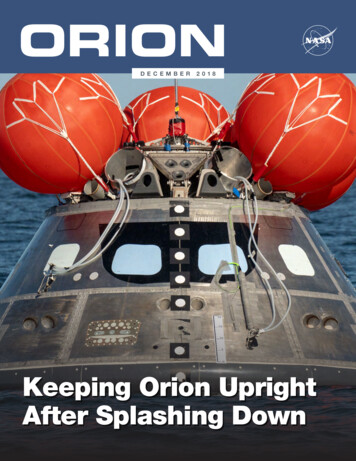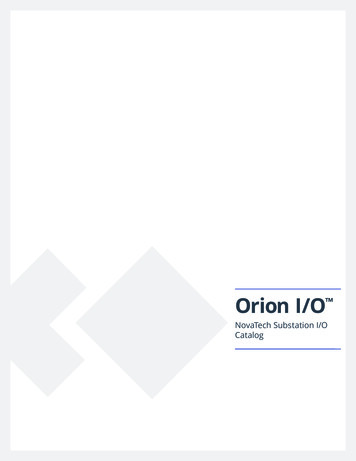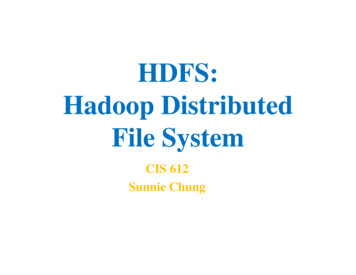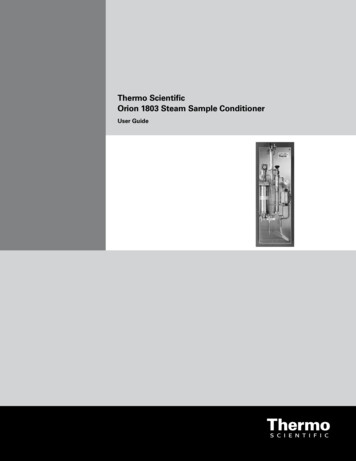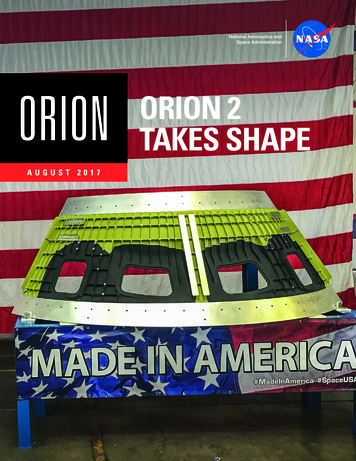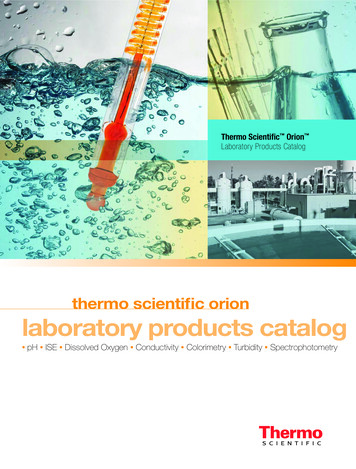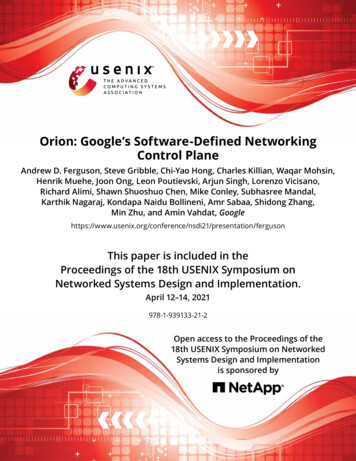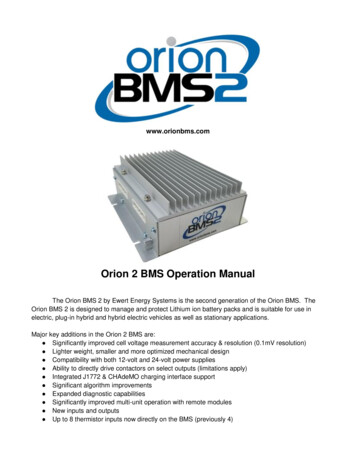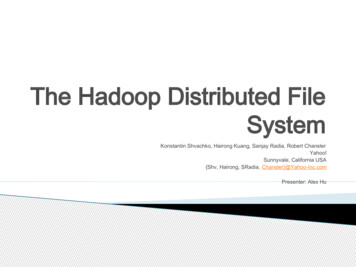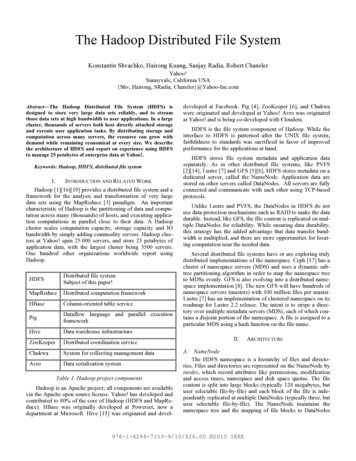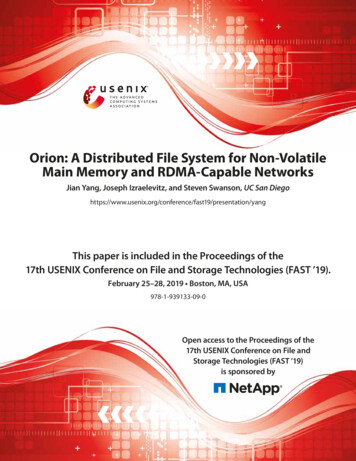
Transcription
Orion: A Distributed File System for Non-VolatileMain Memory and RDMA-Capable NetworksJian Yang, Joseph Izraelevitz, and Steven Swanson, UC San entation/yangThis paper is included in the Proceedings of the17th USENIX Conference on File and Storage Technologies (FAST ’19).February 25–28, 2019 Boston, MA, USA978-1-939133-09-0Open access to the Proceedings of the17th USENIX Conference on File andStorage Technologies (FAST ’19)is sponsored by
Orion: A Distributed File System for Non-Volatile Main Memoriesand RDMA-Capable NetworksJian YangJoseph IzraelevitzUC San Diego{jianyang, jizraelevitz, swanson}@eng.ucsd.eduSteven SwansonAbstractHigh-performance, byte-addressable non-volatile main memories (NVMMs) force system designers to rethink tradeoffs throughout the system stack, often leading to dramaticchanges in system architecture. Conventional distributed filesystems are a prime example. When faster NVMM replacesblock-based storage, the dramatic improvement in storage performance makes networking and software overhead a criticalbottleneck.In this paper, we present Orion, a distributed file systemfor NVMM-based storage. By taking a clean slate designand leveraging the characteristics of NVMM and high-speed,RDMA-based networking, Orion provides high-performancemetadata and data access while maintaining the byte addressability of NVMM. Our evaluation shows Orion achieves performance comparable to local NVMM file systems and outperforms existing distributed file systems by a large margin.1IntroductionIn a distributed file system designed for block-based devices,media performance is almost the sole determiner of performance on the data path. The glacial performance of disks(both hard and solid state) compared to the rest of the storage stack incentivizes complex optimizations (e.g., queuing,striping, and batching) around disk accesses. It also savesdesigners from needing to apply similarly aggressive optimizations to network efficiency, CPU utilization, and locality,while pushing them toward software architectures that areeasy to develop and maintain, despite the (generally irrelevant) resulting software overheads.The appearance of fast non-volatile memories (e.g., Intel’s3D XPoint DIMMs [28]) on the processor’s memory buswill offer an abrupt and dramatic increase in storage systemperformance, providing performance characteristics comparable to DRAM and vastly faster than either hard drives orSSDs. These non-volatile main memories (NVMM) upendthe traditional design constraints of distributed file systems.For an NVMM-based distributed file system, media accessperformance is no longer the major determiner of performance. Instead, network performance, software overhead,USENIX Associationand data placement all play central roles. Furthermore, sinceNVMM is byte-addressable, block-based interfaces are nolonger a constraint. Consequently, old distributed file systemssquander NVMM performance — the previously negligibleinefficiencies quickly become the dominant source of delay.This paper presents Orion, a distributed file system designed from the ground up for NVMM and Remote DirectMemory Access (RDMA) networks. While other distributedsystems [41, 55] have integrated NVMMs, Orion is the firstdistributed file system to systematically optimize for NVMMsthroughout its design. As a result, Orion diverges from blockbased designs in novel ways.Orion focuses on several areas where traditional distributedfile systems fall short when naively adapted to NVMMs. Wedescribe them below.Use of RDMA Orion targets systems connected with anRDMA-capable network. It uses RDMA whenever possibleto accelerate both metadata and data accesses. Some existingdistributed storage systems use RDMA as a fast transportlayer for data access [10, 18, 62, 63, 71] but do not integrate itdeeply into their design. Other systems [41, 55] adapt RDMAmore extensively but provide object storage with customizedinterfaces that are incompatible with file system features suchas unrestricted directories and file extents, symbolic links andfile attributes.Orion is the first full-featured file system that integratesRDMA deeply into all aspects of its design. Aggressive useof RDMA means the CPU is not involved in many transfers,lowering CPU load and improving scalability for handling incoming requests. In particular, pairing RDMA with NVMMsallows nodes to directly access remote storage without anytarget-side software overheads.Software Overhead Software overhead in distributed filessystem has not traditionally been a critical concern. As such,most distributed file systems have used two-layer designs thatdivide the network and storage layers into separate modules.17th USENIX Conference on File and Storage Technologies221
Read Latency Bandwidth GB/s512 BReadWriteDRAM80 ns6030NVMM300 ns82RDMA NIC3 µs5 (40 Gbps)NVMe SSD70 µs3.21.3Table 1: Characteristics of memory and network devicesWe measure the fisrt 3 lines on Intel Sandy Bridge-EP platform with a Mellanox ConnectX-4 RNIC and an Intel DCP3600 SSD. NVMM numbers are estimated based on assumptions made in [75].Section 6 evaluates these mechanisms. We cover related workin Section 7 and conclude in Section 8.2Orion is a file system designed for distributed shared NVMMand RDMA. This section gives some background on NVMMand RDMA and highlights the opportunities these technologies provide. Then, it discusses the inefficiencies inherent inrunning existing distributed file systems on NVMM.2.1Two-layer designs trade efficiency for ease of implementation. Designers can build a user-level daemon that stitchestogether off-the-shelf networking packages and a local filesystem into a distributed file system. While expedient, thisapproach results in duplicated metadata, excessive copying,unnecessary event handling, and places user-space protectionbarriers on the critical path.Orion merges the network and storage functions into a single, kernel-resident layer optimized for RDMA and NVMMthat handles data, metadata, and network access. This decision allows Orion to explore new mechanisms to simplifyoperations and scale performance.Locality RDMA is fast, but it is still several times slowerthan local access to NVMMs (Table 1). Consequently, thelocation of stored data is a key performance concern forOrion. This concern is an important difference between Orionand traditional block-based designs that generally distinguish between client nodes and a pool of centralized storagenodes [18, 53]. Pooling makes sense for block devices, sinceaccess latency is determined by storage, rather than networklatency, and a pool of storage nodes simplifies system administration. However, the speed of NVMMs makes a storagepool inefficient, so Orion optimizes for locality. To encouragelocal accesses, Orion migrates durable data to the client whenever possible and uses a novel delegated allocation scheme toefficiently manage free space.Our evaluation shows that Orion outperforms existing distributed file systems by a large margin. Relative to localNVMM filesystems, it provides comparable application-levelperformance when running applications on a single client.For parallel workloads, Orion shows good scalability: performance on an 8-client cluster is between 4.1 and 7.9 higherthan running on a single node.The rest of the paper is organized as follows. We discussthe opportunities and challenges of building a distributed filesystem utilizing NVMM and RDMA in Section 2. Section 3gives an overview of Orion’s architecture. We describe the design decisions we made to implement high-performance metadata access and data access in Sections 4 and 5 respectively.222Background and MotivationNon-Volatile Main MemoryNVMM is comprised of nonvolatile DIMMs (NVDIMMs)attached to a CPU’s memory bus alongside traditional DRAMDIMMs. Battery-backed NVDIMM-N modules are commercially available from multiple vendors [46], and Intel’s 3DXPoint memory [28] is expected to debut shortly. Other technologies such as spin-torque transfer RAM (STT-RAM) [45],ReRAM [27] are in active research and development.NVMMs appear as contiguous, persistent ranges of physical memory addresses [52]. Instead of using block-basedinterface, file systems can issue load and store instructionsto NVMMs directly. NVMM file systems provide this abilityvia direct access (or “DAX”), which allows read and writesystem calls to bypass the page cache.Researchers and companies have developed several file systems designed specifically for NVMM [15, 21, 25, 73, 74].Other developers have adapted existing file systems toNVMM by adding DAX support [14, 70]. In either case, thefile system must account for the 8-byte atomicity guarantees that NVMMs provide (compared to sector atomicity fordisks). They also must take care to ensure crash consistencyby carefully ordering updates to NVMMs using cache flushand memory barrier instructions.2.2RDMA NetworkingOrion leverages RDMA to provide low latency metadata anddata accesses. RDMA allows a node to perform one-sidedread/write operations from/to memory on a remote node inaddition to two-sided send/recv operations. Both user- andkernel-level applications can directly issue remote DMA requests (called verbs) on pre-registered memory regions (MRs).One-sided requests bypass CPU on the remote host, whiletwo-sided requests require the CPU to handle them.An RDMA NIC (RNIC) is capable of handling MRs registered on both virtual and physical address ranges. For MRson virtual addresses, the RDMA hardware needs to translatefrom virtual addresses to DMA addresses on incoming packets. RNICs use a hardware pin-down cache [65] to acceleratelookups. Orion uses physically addressed DMA MRs, whichdo not require address translation on the RNIC, avoiding17th USENIX Conference on File and Storage TechnologiesUSENIX Association
the possibility of pin-down cache misses on large NVMMregions.Software initiates RDMA requests by posting work queueentries (WQE) onto a pair of send/recv queues (a queue pairor “QP”), and polling for their completion from the completion queue (CQ). On completing a request, the RNIC signalscompletion by posting a completion queue entry (CQE).A send/recv operation requires both the sender and receiverto post requests to their respective send and receive queuesthat include the source and destination buffer addresses. Forone-sided transfers, the receiver grants the sender access to amemory region through a shared, secret 32-bit “rkey.” Whenthe receiver RNIC processes an inbound one-sided requestwith a matching rkey, it issues DMAs directly to its localmemory without notifying the host CPU.Orion employs RDMA as a fast transport layer, and itsdesign accounts for several idiosyncrasies of RDMA:Inbound verbs are cheaper Inbound verbs, including recvand incoming one-sided read/write, incur lower overhead forthe target, so a single node can handle many more inboundrequests than it can initiate itself [59]. Orion’s mechanismsfor accessing data and synchronizing metadata across clientsboth exploit this asymmetry to improve scalability.RDMA accesses are slower than local accesses RDMAaccesses are fast but still slower than local accesses. By combining the data measured on DRAM and the methodologyintroduced in a previous study [75], we estimate the one-sidedRDMA NVMM read latency to be 9 higher than localNVMM read latency for 64 B accesses, and 20 higher for4 KB accesses.RDMA favors short transfers RNICs implement most ofthe RDMA protocol in hardware. Compared to transfer protocols like TCP/IP, transfer size is more important to transferlatency for RDMA because sending smaller packets involvesfewer PCIe transactions [35]. Also, modern RDMA hardwarecan inline small messages along with WQE headers, furtherreducing latency. To exploit these characteristics, Orion aggressively minimizes the size of the transfers it makes.RDMA is not persistence-aware Current RDMA hardware does not guarantee persistence for one-sided RDMAwrites to NVMM. Providing this guarantee generally requires an extra network round-trip or CPU involvement forcache flushes [22], though a proposed [60] RDMA “commit”verb would provide this capability. As this support is not yetavailable, Orion ensures persistence by CPU involvement (seeSection 5.3).3Design OverviewOrion is a distributed file system built for the performancecharacteristics of NVMM and RDMA networking. NVMM’slow latency and byte-addressability fundamentally alter theUSENIX AssociationMDSmetadataNVMM (MDS)Metadata AccessDRAM (Client)Data AccessPooled NVMMUpdate/SyncInternal ClientExternal ClientInternal Clientmeta data (rw)meta data (rw)meta data (ro)Local R/W Data replicationdataRemote R/WData replication Local R/WData StoreData StoredatadatadataReplication groupFigure 1: Orion cluster organization An Orion cluster consists of a metadata server, clients and data stores.relationship among memory, storage, and network, motivating Orion to use a clean-slate approach to combine the filesystem and networking into a single layer. Orion achieves thefollowing design goals: Scalable performance with low software overhead:Scalability and low-latency are essential for Orion tofully exploit the performance of NVMM. Orion achievesthis goal by unifying file system functions and networkoperations and by accessing data structures on NVMMdirectly through RDMA. Efficient network usage on metadata updates: Orioncaches file system data structures on clients. A client canapply file operations locally and only send the changesto the metadata server over the network. Metadata and data consistency: Orion uses a logstructured design to maintain file system consistencyat low cost. Orion allows read parallelism but serializesupdates for file system data structures across the cluster.It relies on atomically updated inode logs to guaranteemetadata and data consistency and uses a new coordination scheme called client arbitration to resolve conflicts. DAX support in a distributed file system: DAX-style(direct load/store) access is a key benefit of NVMMs.Orion allows clients to access data in its local NVMMjust as it could access a DAX-enabled local NVMM filesystem. Repeated access become local access: Orion exploitslocality by migrating data to where writes occur andmaking data caching an integral part of the file systemdesign. The log-structured design reduces the cost ofmaintaining cache coherence. Reliability and data persistence: Orion supports metadata and data replication for better reliability and availability. The replication protocol also guarantees datapersistency.The remainder of this section provides an overview of theOrion software stack, including its hardware and softwareorganization. The following sections provide details of howOrion manages metadata (Section 4) and provides access todata (Section 5).17th USENIX Conference on File and Storage Technologies223
MDSinode12Sync 3inodesdentriesFetch inode & logExternal Clientinodelog23VFSinodesdentriesavoids the frequent context switches, copies, and kernel/usercrossing that conventional two-layer distributed file systemsdesigns require.VFSlogUpdateInternal Clientinodelog13data cacheVFSinodesdentriesdata cacheGlobal Page AddressData StoredataCopy-on-writedataReadFigure 2: Orion software organization Orion exposes as alog-structured file system across MDS and clients. Clientsmaintain local copies of inode metadata and sync with theMDS, and access data at remote data stores or local NVMMdirectly.3.1Cluster OrganizationAn Orion cluster consists of a metadata server (MDS), severaldata stores (DSs) organized in replication groups, and clientsall connected via an RDMA network. Figure 1 shows thearchitecture of an Orion cluster and illustrates these roles.The MDS manages metadata. It establishes an RDMAconnection to each of the clients. Clients can propagate localchanges to the MDS and retrieve updates made by otherclients.Orion allows clients to manage and access a global, sharedpool of NVMMs. Data for a file can reside at a single DS orspan multiple DSs. A client can access a remote DS usingone-sided RDMA and its local NVMMs using load and storeinstructions.Internal clients have local NVMM that Orion manages.Internal clients also act as a DSs for other clients. Externalclients do not have local NVMM, so they can access data onDSs but cannot store data themselves.Orion supports replication of both metadata and data. TheMDS can run as a high-availability pair consisting of a primary server and a mirror using Mojim [76]-style replication. Mojim provides low latency replication for NVMM bymaintaining a single replica and only making updates at theprimary.Orion organizes DSs into replication groups, and the DSsin the group have identical data layouts. Orion uses broadcastreplication for data.3.2Software OrganizationOrion’s software runs on the clients and the MDS. It exposesa normal POSIX interface and consists of kernel modules thatmanage file and metadata in NVMM and handle communication between the MDS and clients. Running in the kernel224The file system in Orion inherits some design elementsfrom NOVA [73, 74], a log-structured POSIX-compliant localNVMM file system. Orion adopts NOVA’s highly-optimizedmechanisms for managing file data and metadata in NVMM.Specifically, Orion’s local file system layout, inode log datastructure, and radix trees for indexing file data in DRAMare inherited from NOVA, with necessary changes to makemetadata accessible and meaningful across nodes. Figure 2shows the overall software organization of the Orion filesystem.An Orion inode contains pointers to the head and tail of ametadata log stored in a linked list of NVMM pages. A log’sentries record all modifications to the file and hold pointers tothe file’s data blocks. Orion uses the log to build virtual filesystem (VFS) inodes in DRAM along with indices that mapfile offsets to data blocks. The MDS contains the metadatastructures of the whole file system including authoritativeinodes and their logs. Each client maintains a local copy ofeach inode and its logs for the files it has opened.Copying the logs to the clients simplifies and acceleratesmetadata management. A client can recover all metadata ofa file by walking through the log. Also, clients can applya log entry locally in response to a file system request andthen propagate it to the MDS. A client can also tell whetheran inode is up-to-date by comparing the local and remotelog tail. An up-to-date log should be equivalent on both theclient and the MDS, and this invariant is the basis for ourmetadata coherency protocol. Because MDS inode log entriesare immutable except during garbage collection and logs areappend-only, logs are amenable to direct copying via RDMAreads (see Section 4).Orion distributes data across DSs (including the internalclients) and replicates the data within replication groups. Tolocate data among these nodes, Orion uses global page addresses (GPAs) to identify pages. Clients use a GPA to locateboth the replication group and data for a page. For data reads,clients can read from any node within a replication groupusing the global address. For data updates, Orion performsa copy-on-write on the data block and appends a log entryreflecting the change in metadata (e.g., write offset, size, andthe address to the new data block). For internal clients, thecopy-on-write migrates the block into the local NVMM ifspace is available.An Orion client also maintains a client-side data cache.The cache, combined with the copy-on-write mechanism, letsOrion exploit and enhance data locality. Rather than relyingon the operating system’s generic page cache, Orion managesDRAM as a customized cache that allows it to access cachedpages using GPAs without a layer of indirection. This alsosimplifies cache coherence.17th USENIX Conference on File and Storage TechnologiesUSENIX Association
4Metadata ManagementClientInode table:Since metadata updates are often on an application’s criticalpath, a distributed file system must handle metadata requestsquickly. Orion’s MDS manages all metadata updates andholds the authoritative, persistent copy of metadata. Clientscache metadata locally as they access and update files, andthey must propagate changes to both the MDS and otherclients to maintain coherence.Below, we describe how Orion’s metadata system meetsboth these performance and correctness goals using a combination of communication mechanisms, latency optimizations,and a novel arbitration scheme to avoid locking.4.1 r addr,l head,l tail,r tail,version RPC Inode log:④MDS③Inode log:Inode:VFSMessage Header⑤CommittedCommitted⑥ ⑥msgbuf addr,r head,unused,r tail,version Inode table:①⑦②VFSopen() :① [Client] send a RPC② [MDS] process the RPC③ [MDS] RDMA Write to inode & first log page ④ [Client] RDMA Read more pagessetattr():⑤ [Client] append, send a log entry, update l tail⑥ [MDS] memcpy & update r tail⑦ [MDS] Update VFSMetadata CommunicationThe MDS orchestrates metadata communication in Orion, andall authoritative metadata updates occur there. Clients do notexchange metadata. Instead, an Orion client communicateswith the MDS to fetch file metadata, commit changes andapply changes committed by other clients.Clients communicate with the MDS using three methodsdepending on the complexity of the operation they need toperform: (1) direct RDMA reads, (2) speculative and highlyoptimized log commits, and (3) acknowledged remote procedure calls (RPCs).These three methods span a range of options from simple/lightweight (direct RDMA reads) to complex/heavyweight(RPC). We use RDMA reads from the MDS whenever possible because they do not require CPU intervention, maximizingMDS scalability.Below, we describe each of these mechanisms in detailfollowed by an example. Then, we describe several additionaloptimizations Orion applies to make metadata updates moreefficient.RDMA reads Clients use one-sided RDMA reads to pullmetadata from the MDS when needed, for instance, on fileopen. Orion uses wide pointers that contain a pointer to theclient’s local copy of the metadata as well as a GPA that pointsto the same data on the MDS. A client can walk through itslocal log by following the local pointers, or fetch the logpages from the MDS using the GPAs.The clients can access the inode and log for a file usingRDMA reads since NVMM is byte addressable. These accesses bypass the MDS CPU, which improves scalability.Log commits Clients use log commits to update metadatafor a file. The client first performs file operations locally byappending a log entry to the local copy of the inode log. Thenit forwards the entry to the MDS and waits for completion.Log commits use RDMA sends. Log entries usually fit intwo cache lines, so the RDMA NIC can send them as inlinedmessages, further reducing latencies. Once it receives theacknowledgment for the send, the client updates its local logUSENIX AssociationInode:⑤Figure 3: Orion metadata communication Orion maintainsmetadata structures such as inode logs on both MDS andclients. A client commit file system updates through LogCommits and RPCs.tail, completing the operation. Orion allows multiple clientsto commit log entries of a single inode without distributedlocking using a mechanism called client arbitration that canresolve inconsistencies between inode logs on the clients(Section 4.3).Remote procedure calls Orion uses synchronous remoteprocedure calls (RPCs) for metadata accesses that involvemultiple inodes as well as operations that affect other clients(e.g., a file write with O APPEND flag).Orion RPCs use a send verb and an RDMA write. An RPCmessage contains an opcode along with metadata updatesand/or log entries that the MDS needs to apply atomically.The MDS performs the procedure call and responds via onesided RDMA write or message send depending on the opcode.The client blocks until the response arrives.Example Figure 3 illustrates metadata communication. Foropen() (an RPC-based metadata update), the client allocates space for the inode and log, and issues an RPC 1 . TheMDS handles the RPC 2 and responds by writing the inodealong with the first log page using RDMA 3 . The client usesRDMA to read more pages if needed and builds VFS datastructures 4 .For a setattr() request (a log commit based metadataupdate), the client creates a local entry with the update andissues a log commit 5 . It then updates its local tail pointeratomically after it has sent the log commit. Upon receivingthe log entry, the MDS appends the log entry, updates the logtail 6 , and updates the corresponding data structure in VFS7.RDMA OptimizationsOrion avoids data copying within17th USENIX Conference on File and Storage Technologies225
ClientMDSNet ThreadsEnqueue (ino%4)12FS ThreadsHandle RPCAcknowledgementRelease bufAppend inode logEnqueue (ino%4)Release buf34CQRDMA bufLog commitinode logTaskQRPCTimelineClient B0 1SendQCR021Update DRAM2RRa Handle RPC0C2Client BUpdate VFS/DRAMGC CheckPending WRsR RDMA Read 1 Append LogC Log commit# Logs1RPCRa2CQ1Client ACurrent task310inode log12302Rb131 2301MDSFigure 4: MDS request handling The MDS handles clientrequests in two stages: First, networking threads handleRDMA completion queue entries (CQEs) and dispatch themto file system threads. Next, file system threads handle RPCsand update the VFS.a node whenever possible. Both client-initiated RDMA readsand MDS-initiated RDMA writes (e.g., in response to anRPC) target client file system data structures directly. Additionally, log entries in Orion contain extra space (shown asmessage headers in Figure 3) to accommodate headers usedfor networking. Aside from the DMA that the RNIC performs,the client copies metadata at most once (to avoid concurrentupdates to the same inode) during a file operation.Orion also uses relative pointers in file system data structures to leverage the linear addressing in kernel memory management. NVMM on a node appears as contiguous memoryregions in both kernel virtual and physical address spaces.Orion can create either type of address by adding the relativepointer to the appropriate base address. Relative pointers arealso meaningful across power failures.4.2Minimizing Commit LatencyThe latency of request handling, especially for log commits,is critical for the I/O performance of the whole cluster. Orionuses dedicated threads to handle per-client receive queues aswell as file system updates. Figure 4 shows the MDS requesthandling process.For each client, the MDS registers a small (256 KB) portionof NVMM as a communication buffer. The MDS handlesincoming requests in two stages: A network thread pollsthe RDMA completion queues (CQs) for work requests onpre-posted RDMA buffers and dispatches the requests to filesystem threads. As an optimization, the MDS prioritizes logcommits by allowing network threads to append log entriesdirectly. Then, a file system thread handles the requests byupdating file system structures in DRAM for a log commitor serving the requests for an RPC. Each file system threadmaintains a FIFO containing pointers to updated log entriesor RDMA buffers holding RPC requests.For a log commit, a network thread reads the inode number,appends the entry by issuing non-temporal moves and thenatomically updates the tail pointer. At this point, other clientscan read the committed entry and apply it to their local copy226Client ASendQinode logRRC01C R CC2(a)301R Rebuild2(b)C30RPC1(c)Figure 5: Metadata consistency in Orion The inode logon Client A is consistent after (a) updating the log entrycommitted by another client using RDMA reads, (c) issuingan RPC, and (b) rebuilding the log on conflicts.of the inode log. The network thread then releases the recvbuffer by posting a recv verb, allowing its reuse. Finally, itdispatches the task for updating in-DRAM data structures toa file system thread based on the inode number.For RPCs, the network thread dispatches the request directly to a file system thread. Each thread processes requeststo a subset of inodes to ensure better locality and less contention for locks. The file system threads use lightweightjournals for RPCs involving inodes that belong to multiplefile system threads.File system threads perform garbage collection (GC) whenthe number of “dead” entries in a log becomes too large.Orion rebuilds the inode log by copying live entries to newlog pages. It then updates the log pointers and increases theversion number. Orion makes this update atomic by packingthe version number and tail pointer into 64 bits. The threadfrees stale log pages after a delay, allowing ongoing RDMAreads to complete. Currently we set the maximal size of filewrites in a log entry to be 512 MB.4.3Client ArbitrationOrion allows multiple clients to commit log entries to a single inode at the same time using a mechanism called clientarbitration rather than distributed locking. Client arbitrationbuilds on the following observations:1. Handling an inbound RDMA read is much cheaper thansending an outbound write. In our experiments, a singlehost can serve over 15 M inbound reads per second butonly 1.9 M outbound writes per second.2. For the MDS, CPU time is precious. Having the MDS initiate messages to maintain consistency will reduce Orionperformance significantly.3. Log append operations are lightweight: each one takesaround just 500 CPU cycles.17th USENIX Conference on File and Storage TechnologiesA client commits a log entry by issuing a send verb andUSENIX Association
polling for its completion. The MDS appends log commitsbased on arrival order and updates log tails atomically. Aclient can determine whether a local inode is up-to-date bycomparing the log length of its local copy of the log and theauthoritative copy at the MDS. Clients can check the lengthof an inode’s log by retrieving its tail pointer with an RDMAread.The client issues these reads in the background when handling an I/O request. If another client has modified the l
Orion is a file system designed for distributed shared NVMM and RDMA. This section gives some background on NVMM and RDMA and highlights the opportunities these technolo-gies provide. Then, it discusses the inefficiencies inherent in running existing distributed file systems on NVMM. 2.1Non-Volatile Main Memory NVMM is comprised of nonvolatile DIMMs (NVDIMMs) attached to a CPU's memory .
